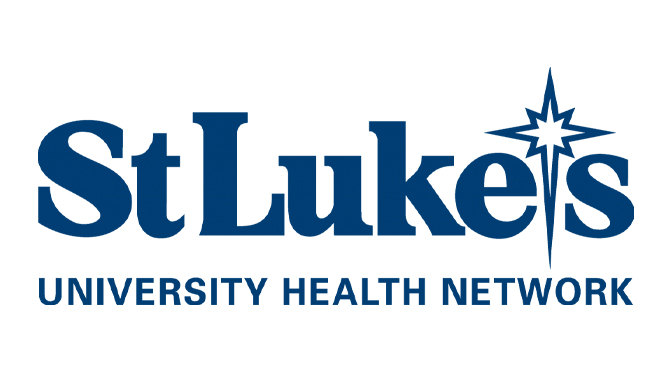St. Luke’s University Health Network vascular surgeons are first in the area to offer a new, incisionless procedure that restores blood supply to the leg by bypassing long, chronic total blockages in the main blood vessel of the leg called the superficial femoral artery.
Percutaneous transmural arterial bypass, or PTAB, creates a bypass around the diseased artery with Dacron coated metal stent tube, branded as TORUS. This technology takes advantage of the fact that there is usually a large, healthy femoral drainage vein that runs right next to the blocked femoral artery.
St. Luke’s is the first hospital in the Lehigh Valley and Northeastern Pennsylvania using this minimally invasive procedure, and one of only three programs in the state currently, noted St. Luke’s chief of vascular surgery, Sharvil Sheth, MD. This novel limb-saving treatment, called DETOUR by its manufacturer, Endologix, is currently being provided to patients with advanced peripheral artery disease (PAD) who are too high-risk to undergo surgery or have failed prior traditional balloon and stent treatments.

“This minimally invasive procedure has been proven to be a safe and effective treatment, and provides hope to several high-risk patients, who may also suffer from diabetes, kidney and heart disease,” Dr. Sheth said. “Restoring blood flow in a leg enhances the patient’s ability to walk painlessly, so they can partake in physical exercise, which helps improve their overall health.”
Unlike traditional methods for treating hardened blocked arteries, including balloon angioplasty and stents–which can have a higher rate of failure–or bypass surgery requiring multiple large incisions along the leg, in this PTAB technique, a surgeon passes a stent from healthy femoral artery in the groin into the adjacent femoral vein and then re-enters into healthy popliteal artery around the knee. It’s like taking a detour in a car, when one of the outbound lanes of the interstate highway is converted to an inbound lane in case of accident or construction, before it rejoins the original inbound lane. In the leg, the outbound lane is usually double the size of the inbound lane and can easily accommodate this extra traffic.
To date, St. Luke’s vascular surgeons Lynne Doctor, MD; Michael Qaqish, MD; and Sharvil Sheth, MD have successfully treated three patients with this innovative technique. This novel incisionless bypass procedure takes place in a St. Luke’s hybrid operating room at its Allentown or Bethlehem campus, requiring about 2.5 hours to complete. Patients are discharged the same day on oral blood thinners.
Peripheral arterial disease is a narrowing or total blockage in the leg that affects about 12 to 19 million Americans. This condition occurs over time due to various risk factors such as smoking, diabetes, high blood pressure and cholesterol that cause fatty deposits in the wall of the blood vessel. These same risk factors can also narrow blood vessels in other parts of the body such as the heart, neck, brain, kidney and intestines. Cardiovascular disease is the leading cause of death and disability in the United States. In advanced cases, leg blockages can progress into non-healing foot wounds, gangrene, and sometimes lead to partial or complete amputation of the foot or leg.
About St. Luke’s
Founded in 1872, St. Luke’s University Health Network (SLUHN) is a fully integrated, regional, non-profit network of more than 20,000 employees providing services at 15 campuses and 350+ outpatient sites. With annual net revenue of $3.4 billion, the Network’s service area includes 11 counties in two states: Lehigh, Northampton, Berks, Bucks, Carbon, Montgomery, Monroe, Schuylkill and Luzerne counties in Pennsylvania and Warren and Hunterdon counties in New Jersey. St. Luke’s hospitals operate the largest network of trauma centers in Pennsylvania, with the Bethlehem Campus being home to St. Luke’s Children’s Hospital.
Dedicated to advancing medical education, St. Luke’s is the preeminent teaching hospital in central-eastern Pennsylvania. In partnership with Temple University, the Network established the Lehigh Valley’s first and only four-year medical school campus. It also operates the nation’s oldest School of Nursing, established in 1884, and 52 fully accredited graduate medical educational programs with more than 500 residents and fellows. In 2022, St. Luke’s, a member of the Children’s Hospital Association, opened the Lehigh Valley’s first and only free-standing facility dedicated entirely to kids.
SLUHN is the only Lehigh Valley-based health care system to earn Medicare’s five-star ratings (the highest) for quality, efficiency and patient satisfaction. It is both a Leapfrog Group and Healthgrades Top Hospital and a Newsweek World’s Best Hospital. The Network’s flagship University Hospital has earned the 100 Top Major Teaching Hospital designation from Fortune/PINC AI 10 years in a row, including in 2023 when it was identified as THE #4 TEACHING HOSPITAL IN THE COUNTRY. In 2021, St. Luke’s was identified as one of the 15 Top Health Systems nationally. Utilizing the Epic electronic medical record (EMR) system for both inpatient and outpatient services, the Network is a multi-year recipient of the Most Wired award recognizing the breadth of the SLUHN’s information technology applications such as telehealth, online scheduling and online pricing information. The Network is also recognized as one of the state’s lowest-cost providers.
Information provided to TVL by:
Sam Kennedy




